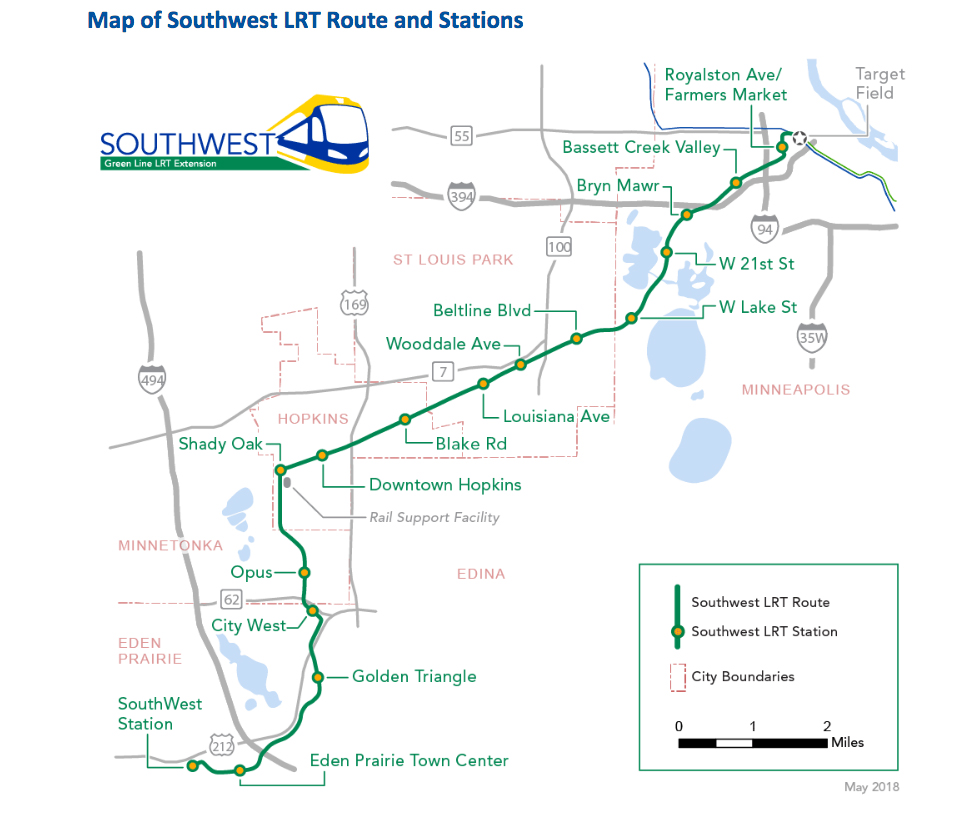
MINNEAPOLIS – The Federal Transit Administration has approved plans for the Twin Cities Metropolitan Council to begin construction on the Southwest Light Rail project, which would be the third light rail line to serve the Minneapolis/St. Paul area. On Wednesday FTA granted the Council what is known as a Letter of No Prejudice, a critical milestone for the project. It makes the early construction work on the project eligible for federal reimbursement upon award of a Full Funding Grant Agreement, anticipated in 2019.
Southwest is a 14.5-mile line with 16 stations that will serve Minneapolis, St. Louis Park, Hopkins, Minnetonka, and Eden Prairie. It will connect with two other light rail lines at the Target Field Station in downtown Minneapolis. With the FTA approval, construction activities are expected to begin this winter including staffing, site clearance, demolition and utility work. Heavy construction would occur in 2019-2022, with testing of the system with new light rail vehicles anticipated in 2022-2023. It is expected to begin passenger service in 2023 as an extension of the existing Green Line, which connects downtown St. Paul and downtown Minneapolis.
For years the project has faced strong opposition. Residents of the tony Kenwood area just west of downtown Minneapolis opposed having light rail pass through their neighborhood, even though for decades the area hosted a Minneapolis & St. Louis and Chicago & North Western freight yard. The yard was removed in the early 1980s, with the right-of-way purchased by the Hennepin County Regional Railroad Authority for future light rail use. A single track was retained through the area, and a trail built next to the track.
In the early 1990s another trail was built on former Milwaukee Road track used by short line Twin Cities & Western, and its trains were rerouted to the line through Kenwood. The agreement to move the trains included a provision that if LRT were built TC&W trains would be rerouted again onto another line, specifically the former Minneapolis, Northfield & Southern through suburban St. Louis Park.
When Southwest was proposed on the right-of-way through Kenwood, opponents argued they didn’t want the trail removed despite the fact the right-of-way was acquired for rail, and not trail use. They argued the trail could be placed on the right-of-way used by TC&W since it would be moved to the ex-MN&S.
As it turned out, planners had grossly underestimated the cost of rebuilding the MN&S line for heavy freight traffic, and building new connections to the existing Canadian Pacific tracks TC&W uses in the area. The MN&S passes through St. Louis Park and its residents didn’t want the freight trains either and began a campaign to stop the reroute.
Eventually the reroute plans were dropped with the railroad remaining in Kenwood, but TC&W feared LRT would drive up its cost of operations and open it up to liability. It filed a Federal lawsuit against the Council and Canadian Pacific, which owns some of the track used by the short line to reach Kenwood. Last summer, the council reached an $18.5 million agreement with the railroad, and it dropped the suit.
BNSF got into the act too, insisting a concrete wall be built along a short stretch of its Wayzata Subdivision west of Target Field to separate light rail and freight trains. The Council agreed to BNSF’s conditions last year.
To mollify Kenwood opposition, Metro Transit agreed to build a tunnel through the area to allow room for the trail and TC&W, but the tunnel contributed to higher costs. As recently as 2012, the price tag of Southwest was $1.25 billion; it’s now over $2 billion. The federal government will pay $929 million of the project’s total cost. Southwest will be the largest infrastructure project in Minnesota history, and is expected to create 7,500 construction jobs with an estimated $350 million payroll.
When complete the line is expected to carry 28,100 daily riders.














The residents of Golden Valley, St Louis Park and Hopkins have wanted and been promised light rail for a generation and finally an actual construction timeline is here. I guarantee you the few NIMBY’s that opposed and delayed it for all will be the first to ride and tout their increased home values. When you look at what Portland Oregon and Seattle have put in place in such a comparatively short amount of time, it really makes you wonder how enlightened Minneapolis actually is and how Austin Texans are so smart they can’t get anything done.
To Charles point, I liken the additional cost to when I moved to St. Louis and they had just opened metrolink cross county extension at a higher cost. It was always reported as over run but the reality was a modification or change in scope of work of taking a portion of an at grade route and place in trench & then underground past/alongside to accomondate Washington University. The terminology being used to report costs in the local papers just wasn’t accurate
Simply put, taking transportation infrastructure below ground just adds cost from the additional excavation or tunneling to ventilation to the multitude of underground utilities that have to be relocated to drainage. In St Louis, I think the added cost resulted in a shorter extension, years of added debt service and probably set back any expansion for years with the added cost that was essentially driven and for the benefit of one institution.
28,100 daily riders. If the case, compare investment in MSP with MKE transit.
“Southwest will be the largest infrastructure project in Minnesota history…” thanks to NIMBYs of all kinds!